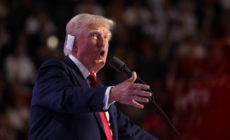-
Kamala Harris Lands Fifth Polling Win in 24 Hours - 5 mins ago
-
How the U.S. Captured One of Mexico’s Biggest Drug Lords - 23 mins ago
-
Mets’ Kodai Senga Exits First Start of Season With Injury - 40 mins ago
-
Fresno County man sentenced for sexually assaulting children, dog - 43 mins ago
-
Doused by Rain, Paris Opens Its Games With a Boat Party on the Seine - about 1 hour ago
-
How to Watch Men’s Tennis at the 2024 Paris Olympics: Streams, Schedule - about 1 hour ago
-
Photos: Paris is the backdrop for a colorful Olympics opening ceremony - about 1 hour ago
-
NASCAR News: This Is Where Corey LaJoie Could Go After Spire Motorsports Exit - 2 hours ago
-
Bullet or Fragment of One Struck Trump’s Ear, F.B.I. Says - 2 hours ago
-
Violent demonstration outside L.A. synagogue sparks second lawsuit - 2 hours ago
New Jersey Ballot Design for Senate Primary Challenged by Federal Judge
A federal judge has granted an emergency request to force New Jersey to redesign its election ballot before the June primary, upending a longstanding source of electoral power for the state’s Democratic and Republican parties.
The ruling, issued on Friday, is expected to fundamentally reshape politics in New Jersey and will have an immediate effect on June’s primary races.
“The integrity of the democratic process for a primary election is at stake,” wrote Zahid N. Quraishi of U.S. District Court for the District of New Jersey in a 49-page decision.
“Plaintiffs have put forth credible evidence not only that their constitutional rights are violated by the present ballot design used in New Jersey, which is used in no other state in the country,” he wrote, adding, “but that defendants would suffer minimal harm in implementing the ballot design requested.”
The implications of Judge Quraishi’s decision have loomed over a high-stakes race to replace Senator Robert Menendez, a New Jersey Democrat accused of accepting bribes in exchange for political favors.
Representative Andy Kim, a Democrat running for Mr. Menendez’s seat, had made concerns over the ballot’s fairness a defining theme of the race, and last month he filed a lawsuit that led to Friday’s judicial decision.
At issue is the unique way New Jersey designs its primary election ballots. In most counties, the ballots bracket together certain groups of candidates in the same column based on endorsements by political party leaders, rather than grouping candidates together based on the office for which they are running.
For months, Tammy Murphy, the wife of Gov. Philip D. Murphy, was Mr. Kim’s main Senate opponent. Ms. Murphy’s path to victory was heavily dependent on the support of influential Democratic Party bosses who had ties to her husband and enough clout to ensure that her name would appear in the pre-eminent spot on the June 4 primary ballot.
Ms. Murphy dropped out of the race last Sunday, but the legal battle over the ballot’s design — a banal but fundamental component of electoral power in New Jersey — continued to dominate the political discussion in the state.
Groups that have long fought to abolish the ballot design hailed Judge Quraishi’s ruling.
“It’s a new day in New Jersey,” said Antoinette Miles, who leads Working Families, a left-leaning alliance that since 2020 had been pushing for the court to order a new ballot design.
“Voters will finally have a meaningful choice. Candidates, no matter their background, will finally be able to enter politics on their own terms,” Ms. Miles said. “And we will finally have a system where officials are accountable to the voters rather than to the preferences of party insiders.”
In 19 of the state’s 21 counties, local political leaders cluster their preferred candidates for every office in a prominent row or column on primary ballots — a position that in New Jersey is known as “the line.” Primary challengers’ names appear off to the side or at the ballot’s edge, a spot candidates call “ballot Siberia.”
Candidates whose names appear on the county line typically win. This enables county political leaders to use ballot position to reward or punish candidates, encouraging fealty. It also gives them outsize control over policy decisions, jobs and government contracts, while simultaneously diminishing constituents’ ability to sway elections and hold elected officials accountable.
Mr. Kim had asked Judge Quraishi to instead require election officials to display the names of all the candidates running for each open position together in a discrete section of the ballot, as is done in the other 49 states.
In testimony last week during a daylong hearing in Judge Quraishi’s courtroom, Mr. Kim, 41, argued that he risked irreparable harm if the ballot were not redesigned before the primary.
Hours before the hearing, the state’s attorney general, Matthew J. Platkin, a Democrat and longtime ally of the governor, wrote to Judge Quraishi that he agreed the ballot design was unconstitutional.
Ms. Murphy dropped out of the race a week later.
Lawyers for county political leaders, hoping to salvage their ballot-design advantage, argued that the urgency of Mr. Kim’s request had vanished with Ms. Murphy’s decision to exit the race.
“Today’s decision is a victory for a fairer, more democratic politics in New Jersey,” Mr. Kim said in a statement. “It’s a victory built from the incredible grass-roots work of activists across our state who saw an undemocratic system marginalizing the voices of voters, and worked tirelessly to fix it.”
Studies by professors from Rutgers and Princeton Universities have shown that the county line gives candidates an often insurmountable advantage.
One study by Julia Sass Rubin, an associate dean at the Edward J. Bloustein School of Planning and Policy at Rutgers, found that being on the county line gave congressional candidates an advantage of 38 percentage points.
Mr. Kim’s lawsuit also included a real-time experiment showing the effect of the ballot’s design by Josh Pasek, a University of Michigan professor who has written books about voter behavior. Dr. Pasek distributed sample ballots to more than 600 New Jersey Democratic voters, but alternated the location in which Mr. Kim’s, Ms. Murphy’s and other candidates’ names appeared.
He concluded that the county line “strongly nudged” voters toward specific candidates.
“The party-column ballot format changes the election choices voters make to ones that are more heavily shaped by party insiders and less by voter preferences,” Dr. Pasek wrote in a report filed with the lawsuit.



















